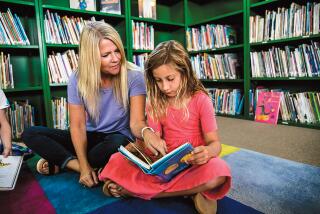Prop. 30 isn’t perfect, but if it fails, the results will be tragic
It’s the kind of education news that never makes headlines: Dozens of teachers and principals from both charter and district-run schools across the Southland gathered last weekend at Loyola Marymount University to talk about what’s working in their classrooms.
The ideas were eye-opening — a mix of innovation and common sense, data analysis and gut-level grit. And so was the energy.
But the celebration couldn’t mask the sense of desperation in the room: California’s public schools are on life support, and the breathing tube may be yanked out soon.
Five weeks from now, California voters will decide whether to dig deeper into their pockets to help schools and universities stumble through this make-or-break academic year.
Two tax increases are on the ballot. Voters can say ‘yes’ to more than one. The one with the most votes will prevail — but only if it garners more than 50% of ballots cast.
The underdog is Proposition 38, which would raise about $10 billion a year by increasing income taxes for 12 years on all but the lowest-income workers. About three-quarters of that money would go directly to schools. Some could be spent only on preschool programs or technology.
It’s the brainchild of wealthy civil rights lawyer Molly Munger, who has spent $28 million of her own money to fund its slowly tanking campaign.
I like that the money it raises wouldn’t be subject to legislative shenanigans. That, according to pollsters, is what accounts for its civic traction.
But its prescriptive spending bothers me. Its bookkeeping requirements would saddle short-staffed campuses with a burdensome bureaucracy. And because higher education is left out, what will happen 12 years from now, when all those early-educated students are lining up for college spots that aren’t there?
The front-runner is Proposition 30, a temporary combination of sales and income tax hikes crafted by Gov. Jerry Brown to backfill budget gaps.
But prospects don’t look good right now. It’s favored by barely half of those polled.
The package would raise $6 billion a year, the bulk earmarked for public schools by state education spending rules. Its income tax increase would last for seven years and apply only to those making over $250,000 a year. Its 0.25% sales tax increase would expire after four years.
But the measure’s biggest selling point is what happens if it doesn’t pass: Massive, crippling mid-year cuts in public schools — from pre-kindergarten programs to Cal State and University of California campuses.
Sacramento is playing an ugly game, holding almost 7 million students hostage with a budget deal that calls for $6 billion in immediate cuts to schools and colleges if the tax increase fails to pass.
In Los Angeles Unified, that would lop 15 more days from this school year, which has already been cut by five. Cal State and UC would face a $500-million budget gap this spring, to be covered with … you guessed it. More tuition hikes.
You can rail, as I have, about fat pay raises for college presidents, money-grubbing legislators, school district indifference and union intransigence.
But on election day, I hope you’ll do as I will: Hold your nose if you have to, but vote yes on Proposition 30.
::
This is not a commercial for public education. Consider it a reality check. I’ve seen plenty in schools to criticize, as a journalist and a parent.
But I’ve also seen glimmers of hope that go beyond test scores (rising), access to college (expanding) and attitudes (improving) on Los Angeles campuses and beyond. Without an infusion of cash right now, we risk losing ground on all of that.
Next year, said Los Angeles Unified Supt. John Deasy, “the school district, charter schools and all, will tumble off a cliff.” The school year would have to be five weeks shorter. “And after that? … I try to stay away from hyperbole, but that would be the end of public education in California.”
Education has suffered disproportionately during several years of budget cuts. That’s made California a national leader on some embarrassing fronts.
We have the largest prison population in the country, and our public universities have hiked tuition more over the last decade than any other state.
In kindergarten through 12th grade, our public schools have the highest student-staff ratio, which translates to the most crowded classes. And we’re 47th in per-student spending. We were fifth when my generation was in school.
It’s no wonder our student achievement numbers leave little to brag about.
You can — as many people do — blame illegal immigrants or lazy teachers or dysfunctional families. Latching on to a stereotype makes it easier to turn your back on those schools, those problems, those students.
That could hurt come election day, because 70% of voters have no children in public schools. They rely on news that tends to be heavy on scandal and light on success stories.
“There’s a crisis of confidence in our schools,” State Supt. of Public Instruction Tom Torlakson acknowledged at the Education Success Project’s conference last weekend. And that’s a lot to overcome in an era when every penny counts.
But the biggest hindrance may not be school performance. Voters believe, polls suggest, that legislators and bureaucrats are nickel-and-diming schools to death.
Public schools need two things to thrive: Enough money to innovate, and enough independence to move beyond the old way of doing things.
I’m willing to help on the money end, but my check comes with a caveat: Lawmakers, grow a backbone. Stand up to special interests. Listen to progressive thinkers. Don’t let unions or corporate moguls dictate how we spend it.
This bailout won’t benefit me. My last child is in her last year of college, at a Cal State campus, where tuition has nearly doubled in four years and left me in debt up to my ears.
But public school quality affects us all. We can pay now in higher taxes, or we can shoulder the burden of an uneducated populace later.
The stability, safety and success of our state and our communities rest on the quality of our public schools. Job growth, housing values, who stays in California and who moves on — all of that is on the line when you cast your ballot on Nov. 6.
I don’t want to live in a state that spends more on its prisoners than its children.
The need for help now is real, and the damage will be monstrous without it.
More to Read
Start your day right
Sign up for Essential California for news, features and recommendations from the L.A. Times and beyond in your inbox six days a week.
You may occasionally receive promotional content from the Los Angeles Times.






